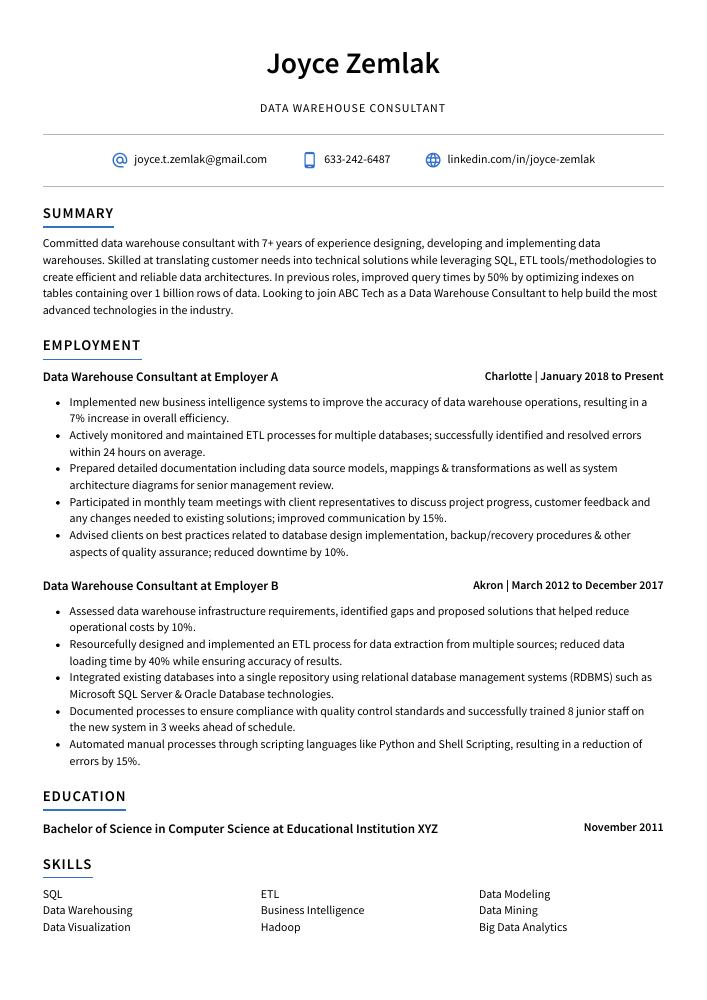Data Warehouse Consultant Resume Guide
Data warehouse consultants analyze and design data warehouses to help businesses better understand their data. They develop, implement, and maintain the systems that store critical business information in an organized way. Additionally, they ensure that the system meets all security standards while providing easy access for users.
Data warehouse consultants are in high demand, and you have the experience to join the ranks. But potential employers don’t know who you are yet. To make yourself stand out from the crowd, compose a resume that emphasizes your expertise and accomplishments.
This guide will walk you through the entire process of creating a top-notch resume. We first show you a complete example and then break down what each resume section should look like.
Table of Contents
The guide is divided into sections for your convenience. You can read it from beginning to end or use the table of contents below to jump to a specific part.
Data Warehouse Consultant Resume Sample
Joyce Zemlak
Data Warehouse Consultant
[email protected]
633-242-6487
linkedin.com/in/joyce-zemlak
Summary
Committed data warehouse consultant with 7+ years of experience designing, developing and implementing data warehouses. Skilled at translating customer needs into technical solutions while leveraging SQL, ETL tools/methodologies to create efficient and reliable data architectures. In previous roles, improved query times by 50% by optimizing indexes on tables containing over 1 billion rows of data. Looking to join ABC Tech as a Data Warehouse Consultant to help build the most advanced technologies in the industry.
Experience
Data Warehouse Consultant, Employer A
Charlotte, Jan 2018 – Present
- Implemented new business intelligence systems to improve the accuracy of data warehouse operations, resulting in a 7% increase in overall efficiency.
- Actively monitored and maintained ETL processes for multiple databases; successfully identified and resolved errors within 24 hours on average.
- Prepared detailed documentation including data source models, mappings & transformations as well as system architecture diagrams for senior management review.
- Participated in monthly team meetings with client representatives to discuss project progress, customer feedback and any changes needed to existing solutions; improved communication by 15%.
- Advised clients on best practices related to database design implementation, backup/recovery procedures & other aspects of quality assurance; reduced downtime by 10%.
Data Warehouse Consultant, Employer B
Akron, Mar 2012 – Dec 2017
- Assessed data warehouse infrastructure requirements, identified gaps and proposed solutions that helped reduce operational costs by 10%.
- Resourcefully designed and implemented an ETL process for data extraction from multiple sources; reduced data loading time by 40% while ensuring accuracy of results.
- Integrated existing databases into a single repository using relational database management systems (RDBMS) such as Microsoft SQL Server & Oracle Database technologies.
- Documented processes to ensure compliance with quality control standards and successfully trained 8 junior staff on the new system in 3 weeks ahead of schedule.
- Automated manual processes through scripting languages like Python and Shell Scripting, resulting in a reduction of errors by 15%.
Skills
- SQL
- ETL
- Data Modeling
- Data Warehousing
- Business Intelligence
- Data Mining
- Data Visualization
- Hadoop
- Big Data Analytics
Education
Bachelor of Science in Computer Science
Educational Institution XYZ
Nov 2011
Certifications
Certified Data Warehousing Professional
Data Warehousing Institute
May 2017
1. Summary / Objective
Your resume summary/objective should be an attention-grabbing introduction to your data warehouse consultant skills and experience. Here is where you can highlight the technical expertise you have in areas such as ETL, SQL, and analytics tools like Tableau or Power BI. You could also mention any certifications or awards that demonstrate your proficiency in this field. Finally, don’t forget to include a brief overview of how you’ve helped past clients achieve their goals through successful data warehousing projects.
Below are some resume summary examples:
Amicable and experienced data warehouse consultant with 7+ years of experience in the technology sector. Skilled at designing, developing and maintaining high-performing data warehouses that enable businesses to achieve their goals. At ABC Company, developed a scalable ETL pipeline for big data analytics which reduced query time by 65%. Actively seeking an opportunity to join XYZ team as a Data Warehouse Consultant where I can leverage my expertise to support organizational objectives.
Passionate data warehouse consultant with 8+ years of experience in designing, developing, and deploying data warehouses. Highly skilled in leading teams to collect and process large datasets for business intelligence purposes. At XYZ Corporation, successfully led the implementation of a real-time data warehouse that allowed for better insights into customer behavior across multiple channels. Experienced communicator eager to join ABC Company as a Data Warehouse Consultant.
Seasoned data warehouse consultant with 8+ years of experience developing and maintaining data warehouses. Expertise in designing, building, managing, and optimizing data models to ensure maximum usability and performance. Successfully designed databases for 3 Fortune 500 companies resulting in 20% cost savings and improved customer satisfaction ratings by 10%. Highly experienced in ETL processes from a variety of sources including Oracle, SQL Server, MySQL etc.
Well-rounded data warehouse consultant with 8+ years of experience designing, developing and maintaining data warehouses to support business intelligence. Proven track record in creating complex ETL processes using SQL Server Integration Services (SSIS), T-SQL, and other related technologies. Seeking a role at ABC Corp that will allow me to apply my expertise in delivering innovative solutions for the organization’s enterprise data needs.
Professional data warehouse consultant with 10+ years of experience in developing, implementing and managing data warehouses. Skilled at leveraging best practices to design solutions that meet business needs. Achieved a 30% reduction in the time needed to develop ETL processes for customer-facing applications while working as a consultant for XYZ Company. Seeking an opportunity to apply my expertise and help ABC maximize its data value.
Determined data warehouse consultant with expertise in the planning, design, and implementation of data warehouses. Experienced in developing ETL processes to ensure data accuracy and integrity. Skilled at evaluating customer requirements and providing appropriate solutions that meet business objectives. Proven track record of success optimizing existing systems while maintaining compliance with industry standards.
Reliable and experienced data warehouse consultant with 10+ years of experience in database design, development, and maintenance. Proven track record of successful implementations for clients ranging from start-ups to Fortune 500 companies using Oracle, SQL Server and Teradata platforms. Skilled at designing efficient ETL processes that extract maximum value out of large datasets while minimizing costs.
Diligent data warehouse consultant with 8+ years of experience developing, managing, and optimizing data systems for Fortune 500 companies. Highly proficient in SQL and Python to construct efficient ETL pipelines that improve reporting accuracy by up to 25%. Seeking the opportunity to join ABC Consulting as a senior-level Data Warehouse Consultant.
2. Experience / Employment
In the experience section, you should list your employment history in reverse chronological order. When writing what you did in each role, use bullet points to make it easier for the reader to digest the information quickly.
Include detail and quantifiable results when possible; this will help demonstrate your value as a candidate. For example, instead of saying “Developed data warehouse solutions,” you could say something like “Designed and implemented an automated ETL process that reduced manual labor by 50%, resulting in more efficient data warehousing operations.”
To write effective bullet points, begin with a strong verb or adverb. Industry specific verbs to use are:
- Designed
- Implemented
- Configured
- Optimized
- Monitored
- Analyzed
- Extracted
- Transformed
- Loaded
- Validated
- Documented
- Troubleshot
- Automated
- Integrated
- Upgraded
Other general verbs you can use are:
- Achieved
- Advised
- Assessed
- Compiled
- Coordinated
- Demonstrated
- Developed
- Expedited
- Facilitated
- Formulated
- Improved
- Introduced
- Mentored
- Participated
- Prepared
- Presented
- Reduced
- Reorganized
- Represented
- Revised
- Spearheaded
- Streamlined
- Structured
- Utilized
Below are some example bullet points:
- Revised existing data warehouse infrastructure to optimize storage and retrieval of business intelligence, resulting in a 15% improvement in query response times.
- Developed ETL processes for loading structured and unstructured datasets into the data warehouse; reduced manual entry workload by 25%.
- Substantially enhanced reporting capabilities by converting complex SQL queries into actionable BI dashboards with interactive visualizations; improved user insights by 50%.
- Formulated migration plans for transitioning from on-premise databases to cloud-based systems such as AWS Redshift & Snowflake, saving $10K+ annually in IT costs.
- Facilitated knowledge sharing sessions with senior management team to demonstrate how business decisions can be driven through predictive analytics using the data warehouse platform; increased understanding of key performance metrics by 80%.
- Reorganized and restructured over 15 data warehouses, resulting in improved flow of information and a 25% increase in query performance.
- Transformed complex datasets into actionable insights for senior management by implementing ETL processes to ensure the accuracy and completeness of analytical results.
- Reliably monitored critical database operations such as backup/restore jobs, index rebuilds, SQL server patching & security patches with zero downtime incidents on all projects handled till date.
- Demonstrated advanced knowledge of T-SQL coding techniques when creating stored procedures and functions that automated tasks such as load balancing across multiple servers, eliminating manual work hours by 30%.
- Structured databases using best practice designs principles while ensuring scalability and optimization; reduced system crashes caused due to inefficient code structure by 45%.
- Achieved a 25% decrease in data warehouse maintenance costs by streamlining processes and automating routine tasks.
- Utilized SQL, NoSQL & Hadoop to develop and maintain multiple large-scale data stores for a global customer base of over 500 clients.
- Diligently monitored all database operations to ensure complete accuracy and integrity of collected information; eliminated errors from the system resulting in 15 hours saved per week on average.
- Improved organizational efficiency by integrating existing databases with new software applications while maintaining tight security protocols at all times; reduced downtime incidents by 40%.
- Designed complex queries, stored procedures and triggers as part of ETL operations that optimized performance across the entire data warehousing environment; improved query speeds up to 30%.
- Confidently managed multiple data warehouse projects, ensuring that the ETL processes were carried out accurately and on time for over 40 clients.
- Optimized current databases to reduce processing times by up to 20% and improve overall performance of systems; reduced downtime from 8 hours/week to 1 hour/week.
- Spearheaded complex initiatives such as an enterprise wide data migration effort which was completed within budget and 2 months ahead of schedule, saving $125K in labor costs.
- Loaded large volumes of structured & unstructured data into different types of warehouses (including relational & non-relational) with a near perfect success rate (+98%).
- Monitored analytical functions & KPIs generated from the various data sources in order to identify trends or discrepancies; identified new opportunities for revenue growth through analysis which increased sales by 15%.
- Expedited data warehouse development by 40% through the use of automation tools and cutting-edge technologies; implemented a successful data transformation process to improve system performance.
- Extracted insights from large volumes of structured and unstructured data, allowing for more accurate decision making in critical areas such as marketing and operations; increased accuracy rate by 15%.
- Streamlined processes related to ETL (Extract, Transform & Load) activities, resulting in an overall reduction in costs associated with warehousing operations by 20%.
- Successfully designed multiple warehouses using dimensional models while designing star schemas that integrated different sources into one consolidated database; reduced time spent on complex queries and reporting tasks by 50%.
- Compiled detailed reports outlining project scope, timelines, objectives, results analysis etc., ensuring executives had real-time access to key metrics influencing business decisions across departments.
- Troubleshot data warehouse architecture to resolve issues and determine root causes; reduced implementation time for data warehouses by 28%.
- Consistently maintained 99% uptime of the data warehouse platform, minimizing business disruptions and improving customer satisfaction ratings.
- Coordinated with software engineers, product analysts, database developers and other stakeholders to ensure successful migration from legacy systems into the new cloud-based model.
- Introduced automated processes for maintaining ETL pipelines which improved efficiency in loading/unloading datasets by 35%.
- Mentored 8 junior consultants on various aspects of Data Warehouse Architecture such as indexing techniques & query optimization practices, leading a team that achieved an average cost savings of $75K per project cycle.
- Reduced data warehousing costs by 30% through optimization of existing resources and leveraging third-party vendors.
- Represented the company at industry conferences to promote data warehouse solutions, increasing brand awareness across a wide customer base.
- Upgraded ETL processes with new technology, resulting in improved system performance and increased productivity by 20%.
- Meticulously designed & developed dimensional databases for analytics purposes; integrated multiple sources of data into single warehouses within strict time frames on schedule for every project undertaking.
- Configured SSIS packages to automate daily ETL operations, consolidating over 200 million records per month while minimizing latency issues significantly (>80%).
- Presented data warehouse solutions and strategies for over 200 clients, reducing implementation timeline by 30% on average.
- Validated data sources from multiple databases & systems to ensure accuracy and completeness of the warehouses before setting up ETL processes; increased data quality by 25%.
- Analyzed client requirements and identified potential gaps in existing infrastructure; designed and developed customized solutions that boosted performance rate by 35%.
- Competently managed 10+ concurrent projects while ensuring successful completion within time & budget constraints; saved an estimated $50K in operational costs annually.
3. Skills
Skill requirements will differ from employer to employer – this can easily be determined via the job advert. Organization ABC may require the candidate to have experience with Oracle, while Organization XYZ may prefer someone who has worked with Microsoft SQL Server.
It is essential to tailor your skills section according to each job you are applying for because of the applicant tracking systems used by many employers today. These computer programs scan resumes for certain keywords and characteristics before passing them on to a human recruiter or hiring manager.
In addition, you should also elaborate on some of your most important skills in other sections such as the summary or work experience areas of your resume.
Below is a list of common skills & terms:
- Big Data Analytics
- Business Intelligence
- Cloud Computing
- Data Mining
- Data Modeling
- Data Visualization
- Data Warehousing
- ETL
- Hadoop
- SQL
4. Education
Mentioning an education section on your resume will depend on how far along you are in your career. If you have just graduated and lack any work experience, include an education section below your resume objective. However, if you have been working as a data warehouse consultant for years with plenty of accomplishments to showcase, omitting the education section is perfectly fine.
If including an education section, try to mention courses and subjects relevant to the data warehouse consulting role that make sense for employers to see.
Bachelor of Science in Computer Science
Educational Institution XYZ
Nov 2011
5. Certifications
Certifications are a great way to demonstrate your expertise in a particular field. They can be especially helpful when applying for jobs that require specific skills or knowledge, as they prove you have been tested and certified by an accredited organization.
Include any certifications relevant to the job you are applying for on your resume to show employers that you possess the necessary qualifications and experience needed for success in the role.
Certified Data Warehousing Professional
Data Warehousing Institute
May 2017
6. Contact Info
Your name should be the first thing a reader sees when viewing your resume, so ensure its positioning is prominent. Your phone number should be written in the most commonly used format in your country/city/state, and your email address should be professional.
You can also choose to include a link to your LinkedIn profile, personal website, or other online platforms relevant to your industry.
Finally, name your resume file appropriately to help hiring managers; for Joyce Zemlak, this would be Joyce-Zemlak-resume.pdf or Joyce-Zemlak-resume.docx.
7. Cover Letter
Submitting a cover letter is an essential part of a job application. It is usually comprised of 2 to 4 paragraphs and serves as the perfect opportunity for you to explain why you are the ideal candidate for the role.
Cover letters provide employers with more insight into your professional background, skillset and personality than just reading through a resume alone can offer. Despite not being mandatory in most cases, it’s highly recommended that you include one when applying for jobs.
Below is an example cover letter:
Dear Maximo,
I am writing to apply for the Data Warehouse Consultant position at XYZ Corporation. As a data warehouse professional with over 10 years of experience designing and implementing data warehouses, I am confident I would make a valuable contribution to your team.
At my current company, ABC Inc., I have designed and implemented several large-scale data warehouses that support critical business functions such as marketing, finance, and operations. My experience working with diverse teams has taught me how to effectively communicate complex technical concepts to non-technical staff. This ability will be invaluable in helping XYZ Corporation meet its business goals.
In addition to my technical skills, I have a proven track record of successful project management. I have managed projects from start to finish, ensuring they are completed on time and within budget. My strong organizational skills and attention to detail will ensure that any project I work on is a success.
If given the opportunity, I am confident that I can exceed your expectations and make a positive impact on your organization. Please find attached my resume for your review; I look forward to speaking with you soon about this exciting opportunity.
Sincerely,
Joyce
Data Warehouse Consultant Resume Templates
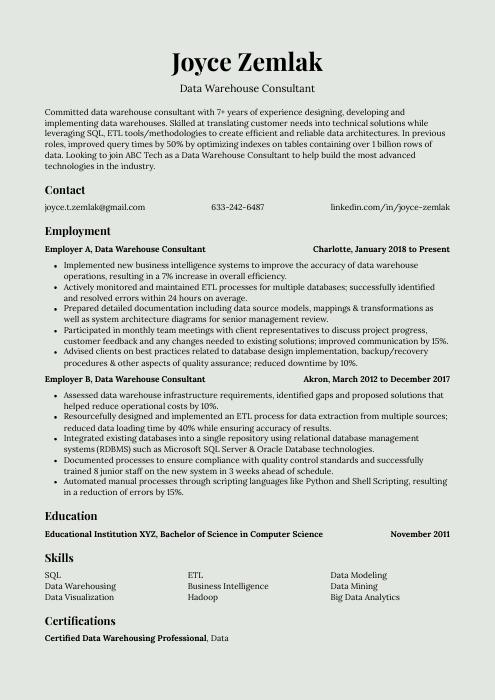 Saola
Saola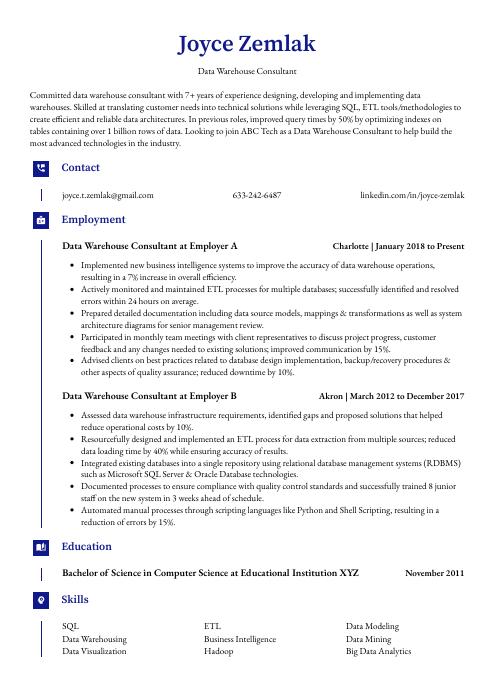 Gharial
Gharial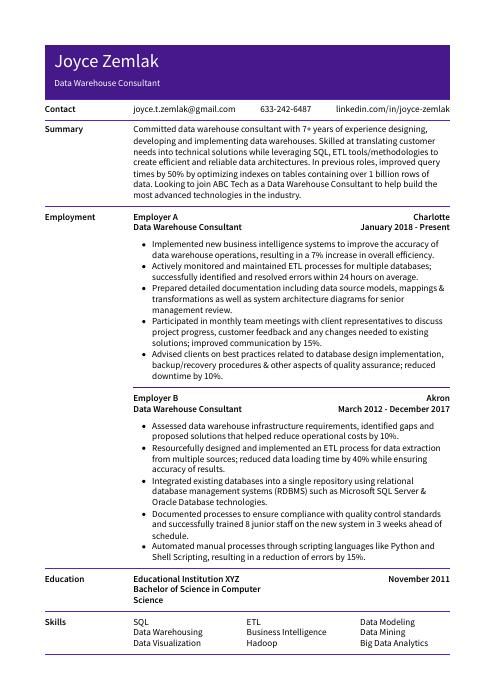 Pika
Pika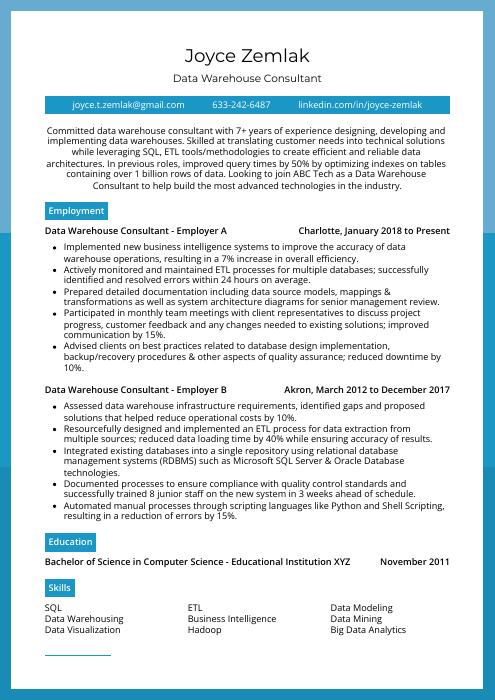 Rhea
Rhea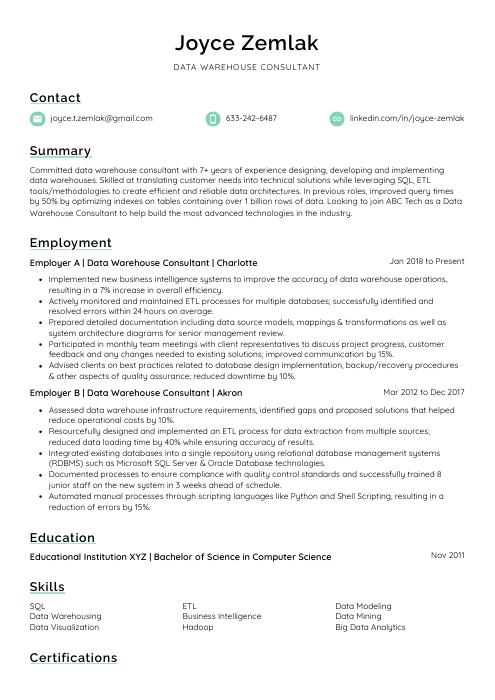 Lorikeet
Lorikeet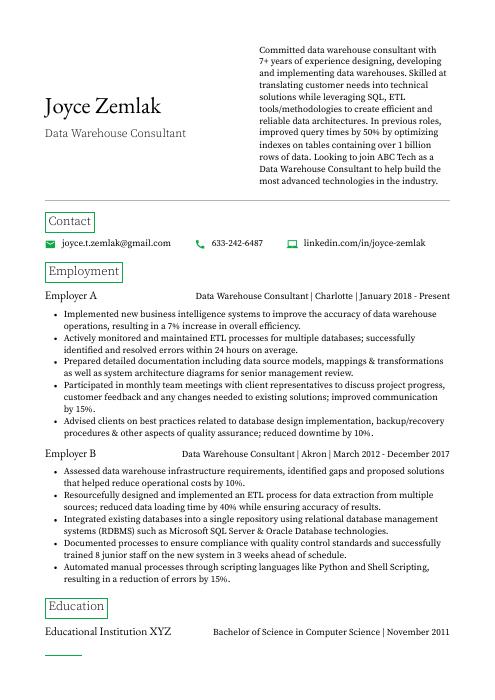 Quokka
Quokka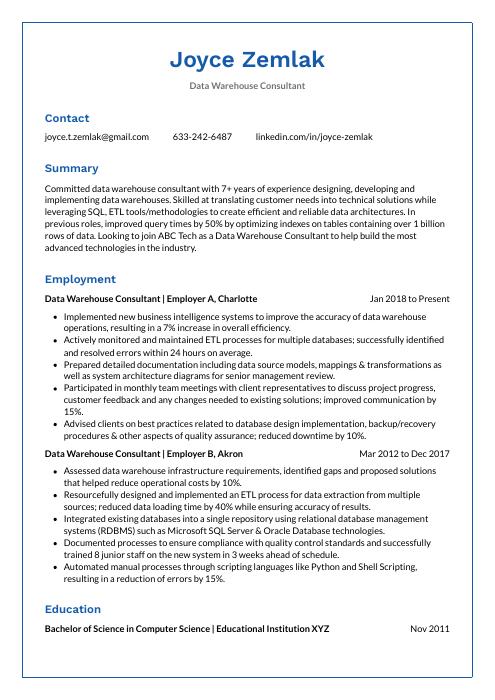 Markhor
Markhor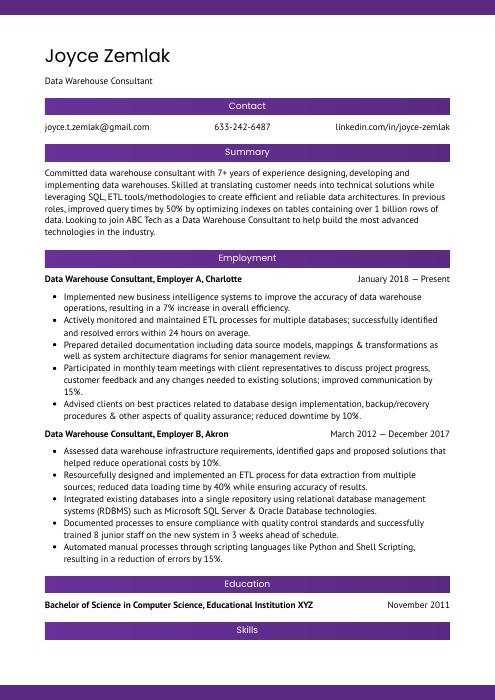 Jerboa
Jerboa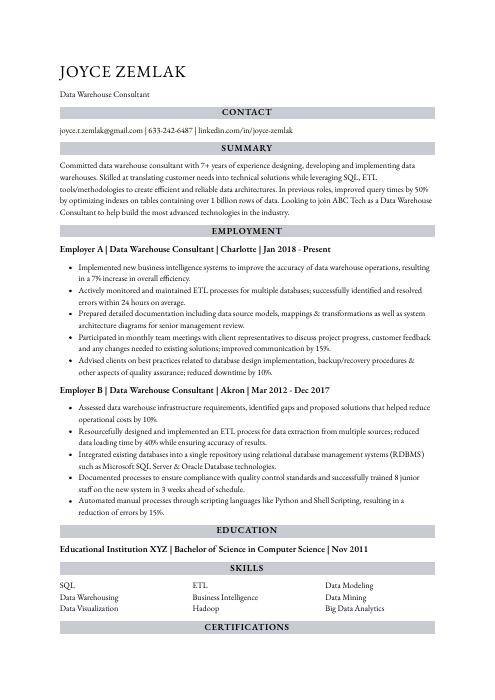 Numbat
Numbat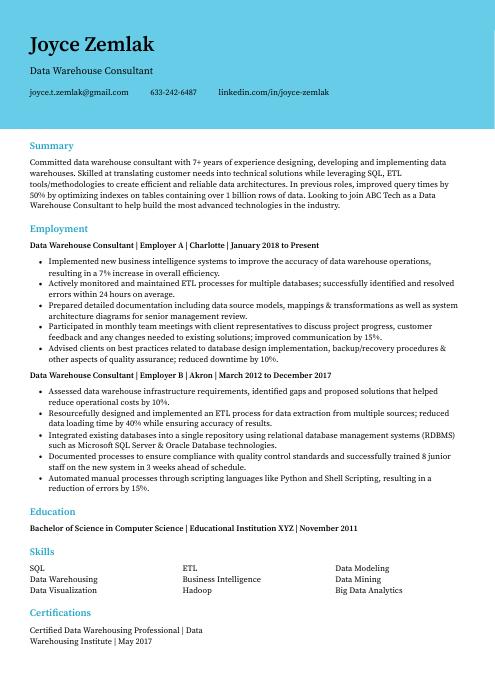 Dugong
Dugong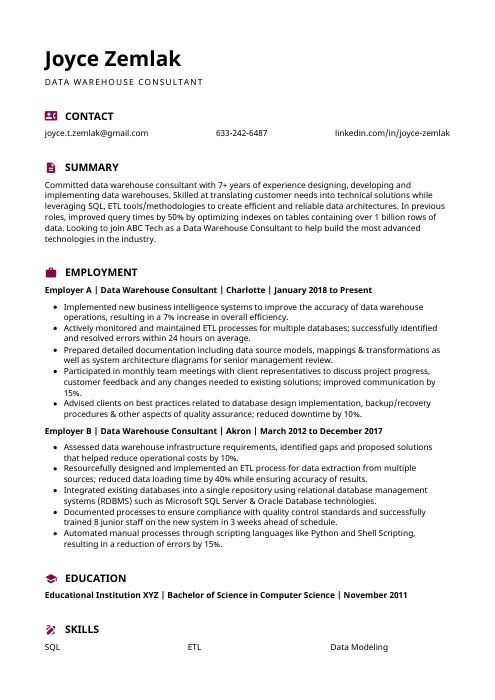 Hoopoe
Hoopoe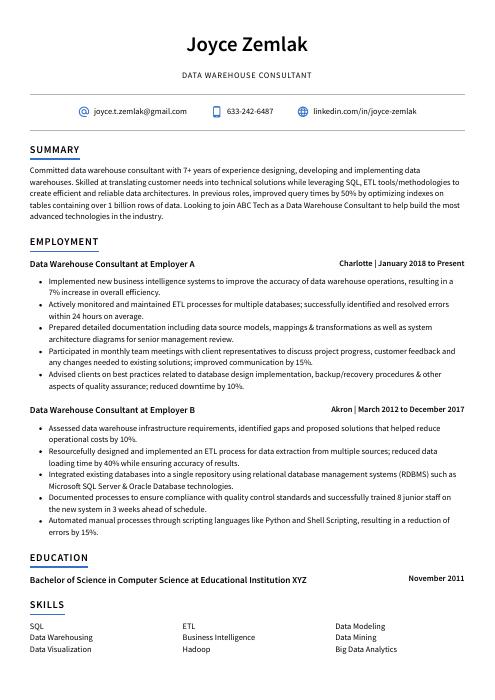 Axolotl
Axolotl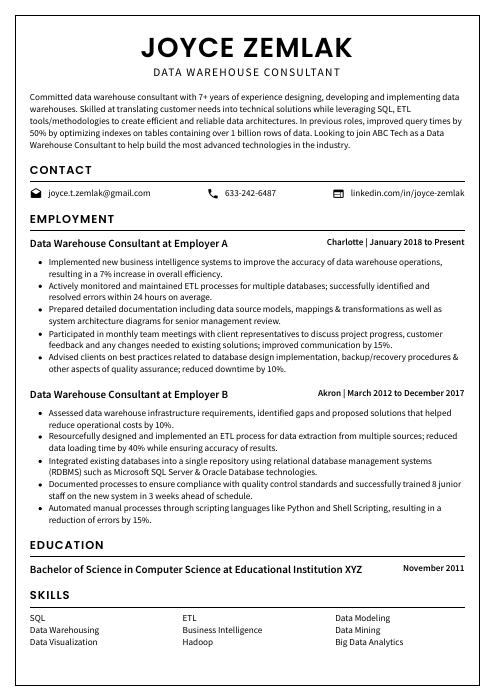 Cormorant
Cormorant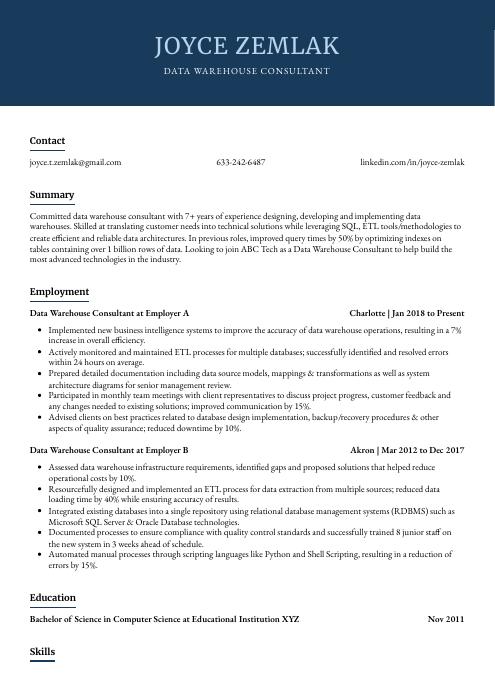 Bonobo
Bonobo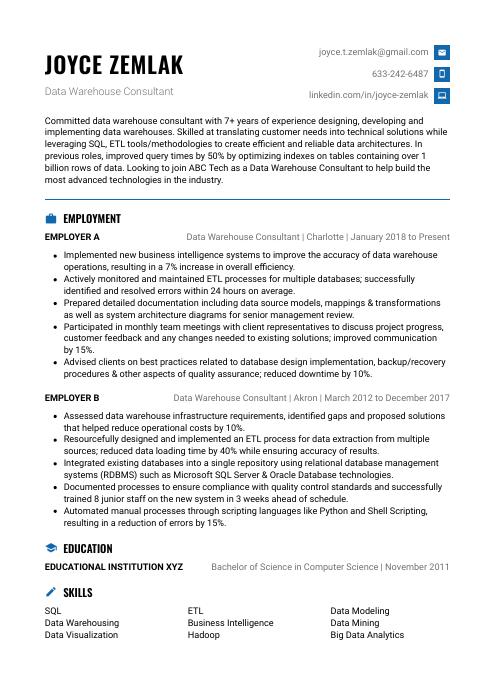 Echidna
Echidna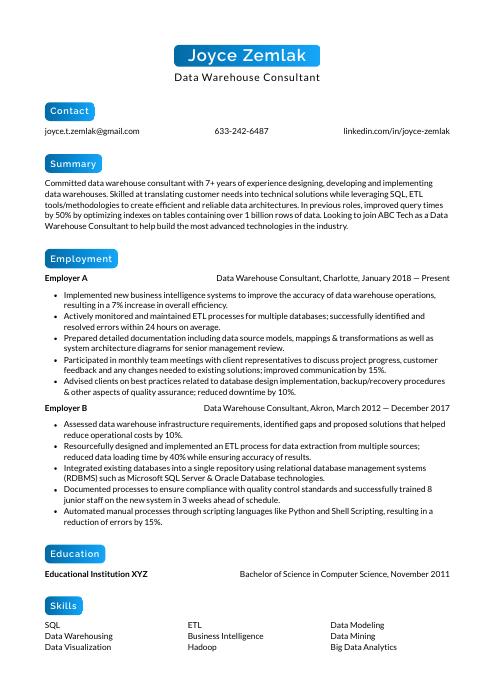 Kinkajou
Kinkajou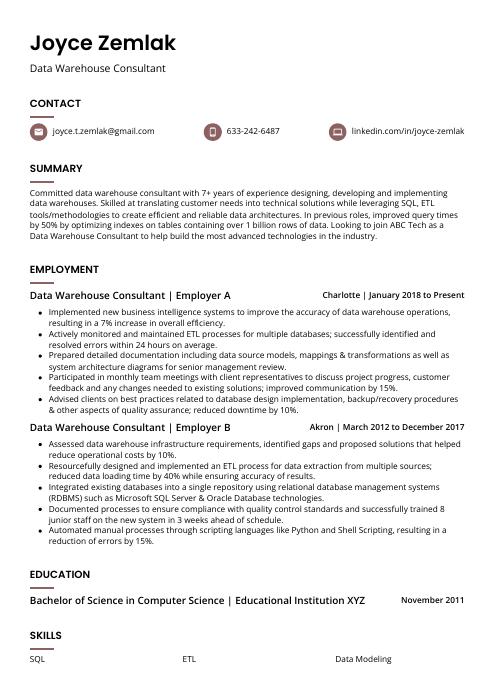 Fossa
Fossa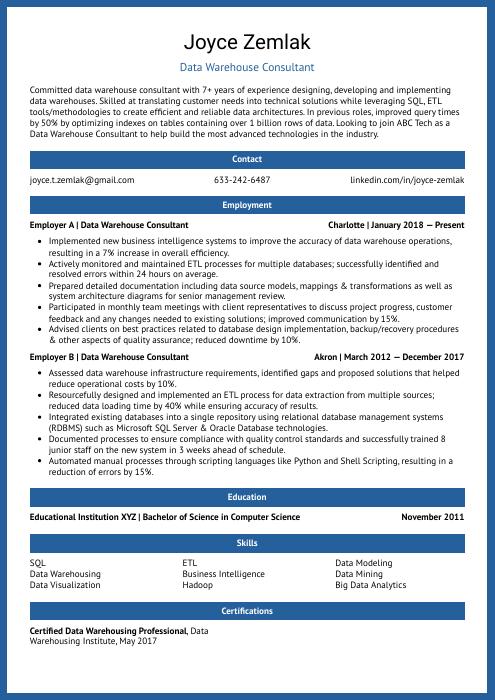 Ocelot
Ocelot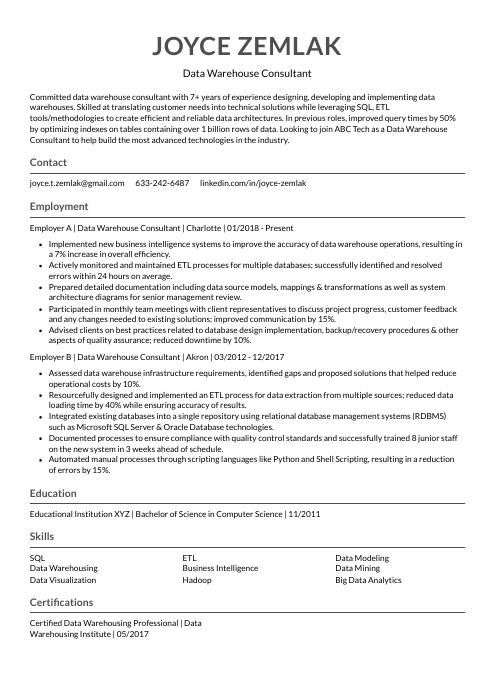 Indri
Indri Rezjumei
Rezjumei
